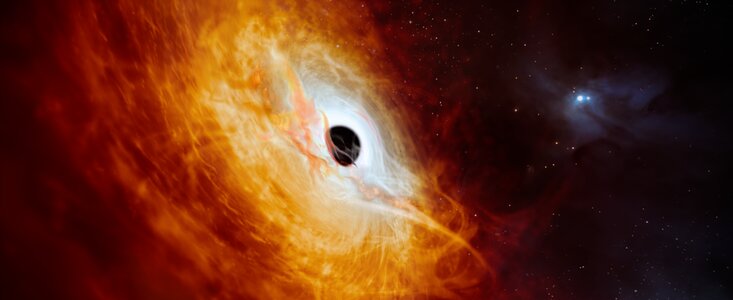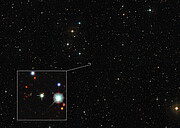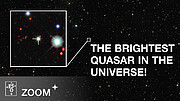Press Release
Brightest and fastest-growing: astronomers identify record-breaking quasar
19 February 2024
Using the European Southern Observatory’s (ESO) Very Large Telescope (VLT), astronomers have characterised a bright quasar, finding it to be not only the brightest of its kind, but also the most luminous object ever observed. Quasars are the bright cores of distant galaxies and they are powered by supermassive black holes. The black hole in this record-breaking quasar is growing in mass by the equivalent of one Sun per day, making it the fastest-growing black hole to date.
The black holes powering quasars collect matter from their surroundings in a process so energetic that it emits vast amounts of light. So much so that quasars are some of the brightest objects in our sky, meaning even distant ones are visible from Earth. As a general rule, the most luminous quasars indicate the fastest-growing supermassive black holes.
“We have discovered the fastest-growing black hole known to date. It has a mass of 17 billion Suns, and eats just over a Sun per day. This makes it the most luminous object in the known Universe,” says Christian Wolf, an astronomer at the Australian National University (ANU) and lead author of the study published today in Nature Astronomy. The quasar, called J0529-4351, is so far away from Earth that its light took over 12 billion years to reach us.
The matter being pulled in toward this black hole, in the form of a disc, emits so much energy that J0529-4351 is over 500 trillion times more luminous than the Sun [1]. “All this light comes from a hot accretion disc that measures seven light-years in diameter — this must be the largest accretion disc in the Universe," says ANU PhD student and co-author Samuel Lai. Seven light-years is about 15 000 times the distance from the Sun to the orbit of Neptune.
And, remarkably, this record-breaking quasar was hiding in plain sight. “It is a surprise that it has remained unknown until today, when we already know about a million less impressive quasars. It has literally been staring us in the face until now,” says co-author Christopher Onken, an astronomer at ANU. He added that this object showed up in images from the ESO Schmidt Southern Sky Survey dating back to 1980, but it was not recognised as a quasar until decades later.
Finding quasars requires precise observational data from large areas of the sky. The resulting datasets are so large, researchers often use machine-learning models to analyse them and tell quasars apart from other celestial objects. However, these models are trained on existing data, which limits the potential candidates to objects similar to those already known. If a new quasar is more luminous than any other previously observed, the programme might reject it and classify it instead as a star not too distant from Earth.
An automated analysis of data from the European Space Agency’s Gaia satellite passed over J0529-4351 for being too bright to be a quasar, suggesting it to be a star instead. The researchers identified it as a distant quasar last year using observations from the ANU 2.3-metre telescope at the Siding Spring Observatory in Australia. Discovering that it was the most luminous quasar ever observed, however, required a larger telescope and measurements from a more precise instrument. The X-shooter spectrograph on ESO’s VLT in the Chilean Atacama Desert provided the crucial data.
The fastest-growing black hole ever observed will also be a perfect target for the GRAVITY+ upgrade on ESO’s VLT Interferometer (VLTI), which is designed to accurately measure the mass of black holes, including those far away from Earth. Additionally, ESO’s Extremely Large Telescope (ELT), a 39-metre telescope under construction in the Chilean Atacama Desert, will make identifying and characterising such elusive objects even more feasible.
Finding and studying distant supermassive black holes could shed light on some of the mysteries of the early Universe, including how they and their host galaxies formed and evolved. But that’s not the only reason why Wolf searches for them. “Personally, I simply like the chase,” he says. “For a few minutes a day, I get to feel like a child again, playing treasure hunt, and now I bring everything to the table that I have learned since.”
Notes
[1] A few years ago, NASA and the European Space Agency reported that the Hubble Space Telescope had discovered a quasar, J043947.08+163415.7, as bright as 600 trillion Suns. However, that quasar’s brightness was magnified by a ‘lensing’ galaxy, located between us and the distant quasar. The actual luminosity of J043947.08+163415.7 is estimated to be equivalent to about 11 trillion Suns (1 trillion is a million million: 1 000 000 000 000 or 1012).
More information
This research was presented in a paper titled “The accretion of a solar mass per day by a 17-billion solar mass black hole” to appear in Nature Astronomy (doi:10.1038/s41550-024-02195-x).
The team is composed of Christian Wolf (Research School of Astronomy and Astrophysics, Australian National University, Australia [ANU] and Centre for Gravitational Astrophysics, Australian National University, Australia [CGA]), Samuel Lai (ANU), Christopher A. Onken (ANU), Neelesh Amrutha (ANU), Fuyan Bian (European Southern Observatory, Chile), Wei Jeat Hon (School of Physics, University of Melbourne, Australia [Melbourne]), Patrick Tisserand (Sorbonne Universités, CNRS, UMR 7095, Institut d’Astrophysique de Paris, France), and Rachel L. Webster (Melbourne).
The European Southern Observatory (ESO) enables scientists worldwide to discover the secrets of the Universe for the benefit of all. We design, build and operate world-class observatories on the ground — which astronomers use to tackle exciting questions and spread the fascination of astronomy — and promote international collaboration for astronomy. Established as an intergovernmental organisation in 1962, today ESO is supported by 16 Member States (Austria, Belgium, Czechia, Denmark, France, Finland, Germany, Ireland, Italy, the Netherlands, Poland, Portugal, Spain, Sweden, Switzerland and the United Kingdom), along with the host state of Chile and with Australia as a Strategic Partner. ESO’s headquarters and its visitor centre and planetarium, the ESO Supernova, are located close to Munich in Germany, while the Chilean Atacama Desert, a marvellous place with unique conditions to observe the sky, hosts our telescopes. ESO operates three observing sites: La Silla, Paranal and Chajnantor. At Paranal, ESO operates the Very Large Telescope and its Very Large Telescope Interferometer, as well as survey telescopes such as VISTA. Also at Paranal ESO will host and operate the Cherenkov Telescope Array South, the world’s largest and most sensitive gamma-ray observatory. Together with international partners, ESO operates ALMA on Chajnantor, a facility that observes the skies in the millimetre and submillimetre range. At Cerro Armazones, near Paranal, we are building “the world’s biggest eye on the sky” — ESO’s Extremely Large Telescope. From our offices in Santiago, Chile we support our operations in the country and engage with Chilean partners and society.
Links
- Research paper
- Photos of the VLT
- Find out more about ESO's Extremely Large Telescope on our dedicated website and press kit
- For journalists: subscribe to receive our releases under embargo in your language
- For scientists: got a story? Pitch your research
Contacts
Christian Wolf
Australian National University
Canberra, Australia
Tel: +61(02)-61256373
Cell: +61(0)415330371
Email: christian.wolf@anu.edu.au
Samuel Lai
Australian National University
Canberra, Australia
Cell: +61 (0) 493418898
Email: samuel.lai@anu.edu.au
Christopher Onken
Australian National University
Canberra, Australia
Tel: +61(0) 26125 8039
Email: christopher.onken@anu.edu.au
Rachel L. Webster (study co-author)
University of Melbourne
Melbourne, Australia
Cell: +61(0) 425863209
Email: r.webster@unimelb.edu.au
Bárbara Ferreira
ESO Media Manager
Garching bei München, Germany
Tel: +49 89 3200 6670
Cell: +49 151 241 664 00
Email: press@eso.org
About the Release
| Release No.: | eso2402 |
| Name: | J0529-4351 |
| Type: | Early Universe : Galaxy : Activity : AGN : Quasar |
| Facility: | Very Large Telescope |
| Instruments: | X-shooter |





